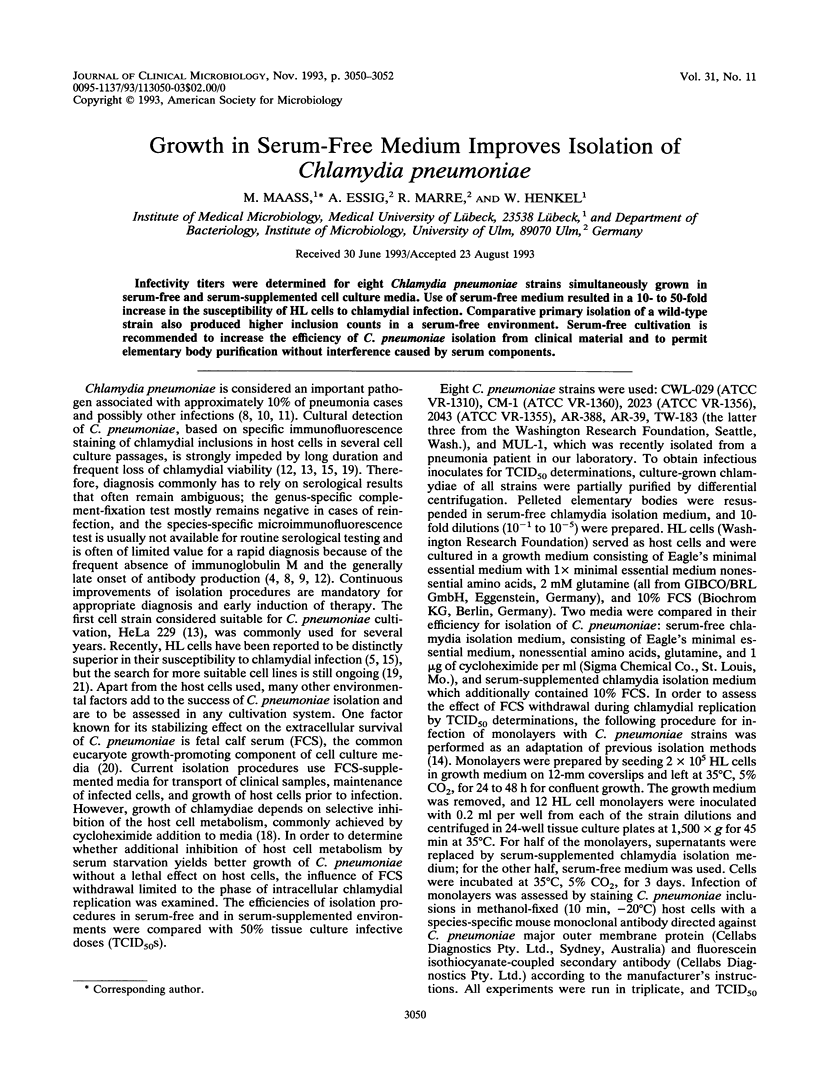Abstract
Infectivity titers were determined for eight Chlamydia pneumoniae strains simultaneously grown in serum-free and serum-supplemented cell culture media. Use of serum-free medium resulted in a 10- to 50-fold increase in the susceptibility of HL cells to chlamydial infection. Comparative primary isolation of a wild-type strain also produced higher inclusion counts in a serum-free environment. Serum-free cultivation is recommended to increase the efficiency of C. pneumoniae isolation from clinical material and to permit elementary body purification without interference caused by serum components.
Full text
PDF


Selected References
These references are in PubMed. This may not be the complete list of references from this article.
- Black C. M., Johnson J. E., Farshy C. E., Brown T. M., Berdal B. P. Antigenic variation among strains of Chlamydia pneumoniae. J Clin Microbiol. 1991 Jul;29(7):1312–1316. doi: 10.1128/jcm.29.7.1312-1316.1991. [DOI] [PMC free article] [PubMed] [Google Scholar]
- Campbell L. A., Kuo C. C., Grayston J. T. Characterization of the new Chlamydia agent, TWAR, as a unique organism by restriction endonuclease analysis and DNA-DNA hybridization. J Clin Microbiol. 1987 Oct;25(10):1911–1916. doi: 10.1128/jcm.25.10.1911-1916.1987. [DOI] [PMC free article] [PubMed] [Google Scholar]
- Chirgwin K., Roblin P. M., Gelling M., Hammerschlag M. R., Schachter J. Infection with Chlamydia pneumoniae in Brooklyn. J Infect Dis. 1991 Apr;163(4):757–761. doi: 10.1093/infdis/163.4.757. [DOI] [PubMed] [Google Scholar]
- Cles L. D., Stamm W. E. Use of HL cells for improved isolation and passage of Chlamydia pneumoniae. J Clin Microbiol. 1990 May;28(5):938–940. doi: 10.1128/jcm.28.5.938-940.1990. [DOI] [PMC free article] [PubMed] [Google Scholar]
- Evans R. T. Suppression of Chlamydia trachomatis inclusion formation by fetal calf serum in cycloheximide-treated McCoy cells. J Clin Microbiol. 1980 Apr;11(4):424–425. doi: 10.1128/jcm.11.4.424-425.1980. [DOI] [PMC free article] [PubMed] [Google Scholar]
- Grayston J. T., Campbell L. A., Kuo C. C., Mordhorst C. H., Saikku P., Thom D. H., Wang S. P. A new respiratory tract pathogen: Chlamydia pneumoniae strain TWAR. J Infect Dis. 1990 Apr;161(4):618–625. doi: 10.1093/infdis/161.4.618. [DOI] [PubMed] [Google Scholar]
- Grayston J. T. Infections caused by Chlamydia pneumoniae strain TWAR. Clin Infect Dis. 1992 Nov;15(5):757–761. doi: 10.1093/clind/15.5.757. [DOI] [PubMed] [Google Scholar]
- Grayston J. T., Kuo C. C., Wang S. P., Altman J. A new Chlamydia psittaci strain, TWAR, isolated in acute respiratory tract infections. N Engl J Med. 1986 Jul 17;315(3):161–168. doi: 10.1056/NEJM198607173150305. [DOI] [PubMed] [Google Scholar]
- Grayston J. T., Wang S. P., Kuo C. C., Campbell L. A. Current knowledge on Chlamydia pneumoniae, strain TWAR, an important cause of pneumonia and other acute respiratory diseases. Eur J Clin Microbiol Infect Dis. 1989 Mar;8(3):191–202. doi: 10.1007/BF01965260. [DOI] [PubMed] [Google Scholar]
- Kuo C. C., Chen H. H., Wang S. P., Grayston J. T. Identification of a new group of Chlamydia psittaci strains called TWAR. J Clin Microbiol. 1986 Dec;24(6):1034–1037. doi: 10.1128/jcm.24.6.1034-1037.1986. [DOI] [PMC free article] [PubMed] [Google Scholar]
- Kuo C. C., Grayston J. T. A sensitive cell line, HL cells, for isolation and propagation of Chlamydia pneumoniae strain TWAR. J Infect Dis. 1990 Sep;162(3):755–758. doi: 10.1093/infdis/162.3.755. [DOI] [PubMed] [Google Scholar]
- Kuo C. C., Grayston J. T. Factors affecting viability and growth in HeLa 229 cells of Chlamydia sp. strain TWAR. J Clin Microbiol. 1988 May;26(5):812–815. doi: 10.1128/jcm.26.5.812-815.1988. [DOI] [PMC free article] [PubMed] [Google Scholar]
- Moulder J. W. Interaction of chlamydiae and host cells in vitro. Microbiol Rev. 1991 Mar;55(1):143–190. doi: 10.1128/mr.55.1.143-190.1991. [DOI] [PMC free article] [PubMed] [Google Scholar]
- Ripa K. T., Mårdh P. A. Cultivation of Chlamydia trachomatis in cycloheximide-treated mccoy cells. J Clin Microbiol. 1977 Oct;6(4):328–331. doi: 10.1128/jcm.6.4.328-331.1977. [DOI] [PMC free article] [PubMed] [Google Scholar]
- Roblin P. M., Dumornay W., Hammerschlag M. R. Use of HEp-2 cells for improved isolation and passage of Chlamydia pneumoniae. J Clin Microbiol. 1992 Aug;30(8):1968–1971. doi: 10.1128/jcm.30.8.1968-1971.1992. [DOI] [PMC free article] [PubMed] [Google Scholar]
- Theunissen J. J., van Heijst B. Y., Wagenvoort J. H., Stolz E., Michel M. F. Factors influencing the infectivity of Chlamydia pneumoniae elementary bodies on HL cells. J Clin Microbiol. 1992 Jun;30(6):1388–1391. doi: 10.1128/jcm.30.6.1388-1391.1992. [DOI] [PMC free article] [PubMed] [Google Scholar]
- Wong K. H., Skelton S. K., Chan Y. K. Efficient culture of Chlamydia pneumoniae with cell lines derived from the human respiratory tract. J Clin Microbiol. 1992 Jul;30(7):1625–1630. doi: 10.1128/jcm.30.7.1625-1630.1992. [DOI] [PMC free article] [PubMed] [Google Scholar]


